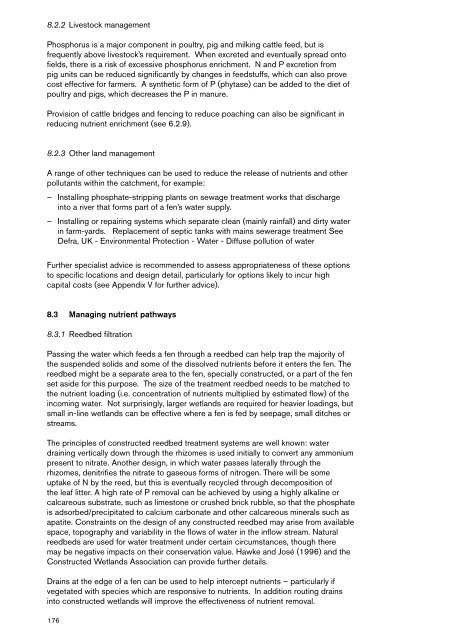Fen Management Handbook - Scottish Natural Heritage
Fen Management Handbook - Scottish Natural Heritage
Fen Management Handbook - Scottish Natural Heritage
Create successful ePaper yourself
Turn your PDF publications into a flip-book with our unique Google optimized e-Paper software.
8.2.2 Livestock management<br />
Phosphorus is a major component in poultry, pig and milking cattle feed, but is<br />
frequently above livestock’s requirement. When excreted and eventually spread onto<br />
fields, there is a risk of excessive phosphorus enrichment. N and P excretion from<br />
pig units can be reduced significantly by changes in feedstuffs, which can also prove<br />
cost effective for farmers. A synthetic form of P (phytase) can be added to the diet of<br />
poultry and pigs, which decreases the P in manure.<br />
Provision of cattle bridges and fencing to reduce poaching can also be significant in<br />
reducing nutrient enrichment (see 6.2.9).<br />
8.2.3 Other land management<br />
A range of other techniques can be used to reduce the release of nutrients and other<br />
pollutants within the catchment, for example:<br />
– Installing phosphate-stripping plants on sewage treatment works that discharge<br />
into a river that forms part of a fen’s water supply.<br />
– Installing or repairing systems which separate clean (mainly rainfall) and dirty water<br />
in farm-yards. Replacement of septic tanks with mains sewerage treatment See<br />
Defra, UK - Environmental Protection - Water - Diffuse pollution of water<br />
Further specialist advice is recommended to assess appropriateness of these options<br />
to specific locations and design detail, particularly for options likely to incur high<br />
capital costs (see Appendix V for further advice).<br />
8.3 Managing nutrient pathways<br />
8.3.1 Reedbed filtration<br />
Passing the water which feeds a fen through a reedbed can help trap the majority of<br />
the suspended solids and some of the dissolved nutrients before it enters the fen. The<br />
reedbed might be a separate area to the fen, specially constructed, or a part of the fen<br />
set aside for this purpose. The size of the treatment reedbed needs to be matched to<br />
the nutrient loading (i.e. concentration of nutrients multiplied by estimated flow) of the<br />
incoming water. Not surprisingly, larger wetlands are required for heavier loadings, but<br />
small in-line wetlands can be effective where a fen is fed by seepage, small ditches or<br />
streams.<br />
The principles of constructed reedbed treatment systems are well known: water<br />
draining vertically down through the rhizomes is used initially to convert any ammonium<br />
present to nitrate. Another design, in which water passes laterally through the<br />
rhizomes, denitrifies the nitrate to gaseous forms of nitrogen. There will be some<br />
uptake of N by the reed, but this is eventually recycled through decomposition of<br />
the leaf litter. A high rate of P removal can be achieved by using a highly alkaline or<br />
calcareous substrate, such as limestone or crushed brick rubble, so that the phosphate<br />
is adsorbed/precipitated to calcium carbonate and other calcareous minerals such as<br />
apatite. Constraints on the design of any constructed reedbed may arise from available<br />
space, topography and variability in the flows of water in the inflow stream. <strong>Natural</strong><br />
reedbeds are used for water treatment under certain circumstances, though there<br />
may be negative impacts on their conservation value. Hawke and José (1996) and the<br />
Constructed Wetlands Association can provide further details.<br />
Drains at the edge of a fen can be used to help intercept nutrients – particularly if<br />
vegetated with species which are responsive to nutrients. In addition routing drains<br />
into constructed wetlands will improve the effectiveness of nutrient removal.<br />
176

















